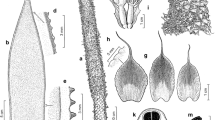Resumen
Se describe e ilustra a Neosprucea chrysantha (Salicaceae), con base en especímenes de remanentes de vegetación en los municipios de Girón y Betulia, en el departamento de Santander, Colombia. La especie nueva difiere de las demás especies conocidas de Neosprucea por sus flores principalmente trímeras a ocasionalmente tetrámeras y la presencia de anteras incurvadas, ligeramente ensanchadas apicalmente con poros transversales. El taxón nuevo se asemeja a Neosprucea paterna por su venación actinódroma, flores amarillas y glándulas del margen de la lámina pilosas, la única especie asociada a la región del Escudo Guayanés, y a Neosprucea rimachii, del noroccidente de la cuenca amazónica. En Colombia se registran siete de las diez especies descritas de Neosprucea, de las cuales dos son endémicas.
Abstract
Neosprucea chrysantha (Salicaceae) is described and illustrated based on specimens from remnant vegetation in the municipalities of Girón and Betulia, Santander Department, Colombia. The new species differs from other known species of Neosprucea by its mainly trimerous to occasionally tetramerous flowers and the presence of incurved anthers, slightly widened apically with transverse pores. The new taxon resembles Neosprucea paterna by its actinodromous venation, yellow flowers, and hairy lamina margin glands, the only species associated with the Guiana Shield region, and Neosprucea rimachii, from the northwestern Amazon basin. Seven of the ten described species of Neosprucea are recorded in Colombia, of which two are endemic.



Similar content being viewed by others
Disponibilidad de los datos
Todos los datos que respaldan las conclusiones de este estudio están disponibles en el texto principal.
Data Availability
All data supporting the conclusions of this study are available in the main text.
Literatura citada
Alford, M.H. 2003. Claves para los géneros de Flacourtiaceae de Perú y del Nuevo Mundo. Arnaldoa 10(2): 19–38.
Alford, M.H., C. Grández & R. Vásquez. 2005. Una nueva especie de Neosprucea (Salicaceae/Flacourtiaceae) de Perú y Colombia. Arnoldoa 11(2): 37–42.
Alford, M. H. 2006. A new species of Hasseltia (Salicaceae) from Costa Rica and Panamá. Brittonia 58: 277–284. https://doi.org/10.1663/0007-196X(2006)58[277:ANSOHS]2.0.CO;2
Alford, M.H. 2008. Revision of Neosprucea (Salicaceae). Systematic Botany Monographs 85: 1–62.
Alford, M.H. 2015. Neosprucea. En Bernal, R., S.R. Gradstein & M. Celis (eds.). Catálogo de Plantas y Líquenes de Colombia. Instituto de Ciencias Naturales, Universidad Nacional de Colombia, Bogotá. http://catalogoplantasdecolombia.unal.edu.co.
Beentje, H. 2010. The Kew Plant Glossary: An Illustrated Dictionary of Plant Terms. Royal Botanic Gardens, Kew, London.
Chase, M.W., S. Zmarzty, M.D. Lledó, K.J. Wurdack, S.M. Swensen & M.F. Fay. 2002. When in doubt, put it in Flacourtiaceae: A molecular phylogenetic analysis based on plastid rbcL DNA sequences. Kew Bulletin 57: 141–181. DOI.org/https://doi.org/10.2307/4110825
Dauby, G., T. Stevart, V. Droissart, A. Cosiaux, V. Deblauwe, M. Simo-Droissart, M. S.M. Sosef, P.P. Lowry II, G.E. Schatz, R.E. Gereau & T.L.P. Couvreur. 2017. ConR: An R package to assist large-scale multispecies preliminary conservation assessments using distribution data. Ecology and Evolution 7: 11292–11303.
Dorr, L.J. & M.H. Alford. 2018. The identity and typification of Valliera triplinervis (Salicaceae). Journal of the Botanical Research Institute of Texas 12(1): 129–131. DOI.org/https://doi.org/10.17348/jbrit.v12.i1.921
Ellis, B., D.C. Daly, L.J. Hickey, K.R. Johnson, J.D. Mitchell, P. Wilf & S.L. Wing. 2009. Manual of Leaf Architecture. Cornell University Press, Ithaca.
Holdridge, L.R. 1987. Ecología Basada en Zonas de Vida. Instituto Interamericano de Cooperación para la Agricultura, San José.
R Core Team (2017) R: A Language and Environment for Statistical Computing. https://www.R-project.org/
Sleumer, H.O. 1980. Flacourtiaceae. Flora Neotropica 22: 1–499.
Thiers, B. Continuously updated. Index Herbariorum: A global directory of public herbaria and associated staff. New York Botanical Garden’s Virtual Herbarium. http://sweetgum.nybg.org/science/ih/ [consultado Junio 2023]
UICN. 2012. Categorías y Criterios de la Lista Roja de la UICN, versión 3.1, ed. 2. Gland, Suiza y Cambridge, Reino Unido: UICN. Originalmente publicado como IUCN Red List Categories and Criteria, version 3.1, 2nd ed. IUCN, Gland and Cambridge.
Author information
Authors and Affiliations
Corresponding author
Additional information
Associate Editor: Julián Aguirre-Santoro
Rights and permissions
Springer Nature or its licensor (e.g. a society or other partner) holds exclusive rights to this article under a publishing agreement with the author(s) or other rightsholder(s); author self-archiving of the accepted manuscript version of this article is solely governed by the terms of such publishing agreement and applicable law.
About this article
Cite this article
Zapata-Correa, D.A., Tobón-Agudelo, J.P. Novedades en Salicaceae para Colombia, una especie nueva de Neosprucea. Brittonia (2024). https://doi.org/10.1007/s12228-024-09781-3
Received:
Revised:
Accepted:
Published:
DOI: https://doi.org/10.1007/s12228-024-09781-3




